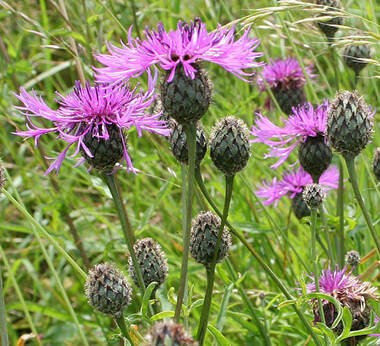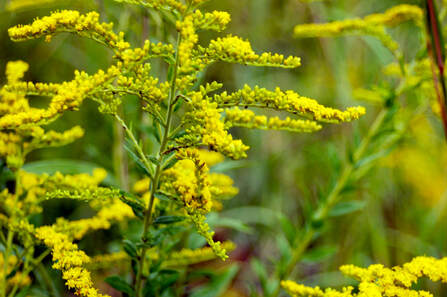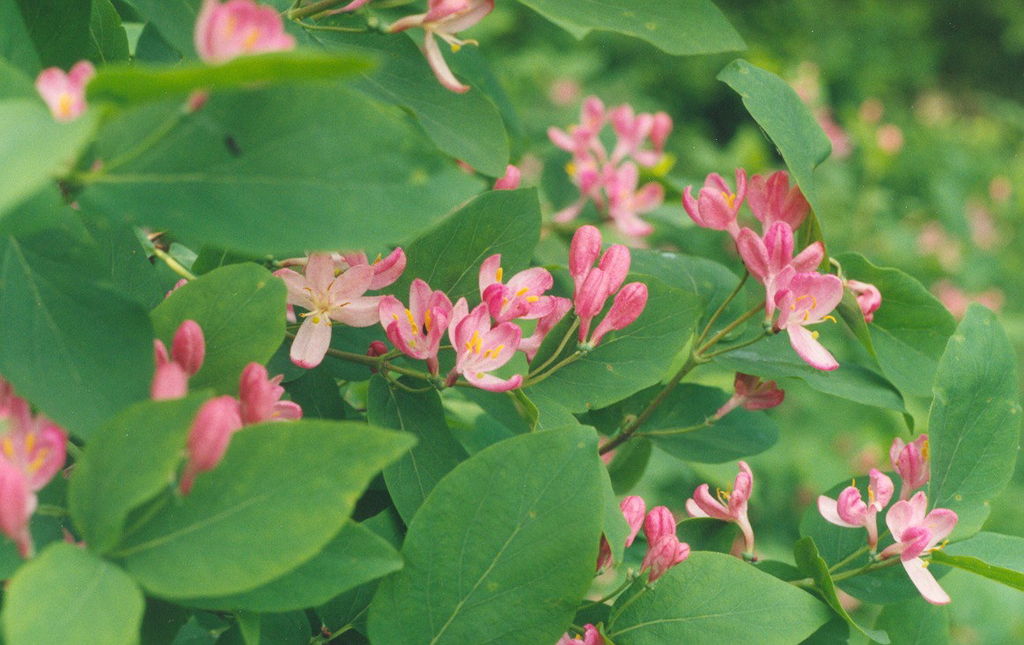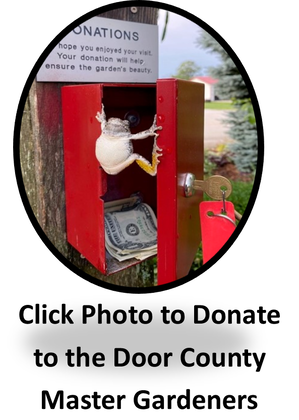Invasive Plants in the Garden
|
Invasive plants threaten native species and habitats by competing for critical and often limited resources. The first step in eliminating the spread of invasive plants is to become familiar with what constitutes an invasive plant. Some of the resources below provide information that can help you determine whether some plants in your garden might be invasive. If you're not sure, bring a stem, leaf or flower from the plant to your local University Extension office for their help in identifying the plant.
There are many things that you can do to eradicate invasive plants from our environment. Below is information regarding invasive plants along with resources that can provide more in-depth information on this subject. |
Wisconsin's NR40 Administrative Rule
 Common Knapweed (Centaurea nigra) Photo: Kate Jewell, Wikicommons (License: Creative Commons Attribution-Share Alike 2.0 Generic)
Common Knapweed (Centaurea nigra) Photo: Kate Jewell, Wikicommons (License: Creative Commons Attribution-Share Alike 2.0 Generic)
In the state of Wisconsin, the Department of Natural Resources has developed, within Administrative Rule Chapter NR 40, a list of plants and animals that are considered invasive species in the state. This science-based rule was developed to provide clear guidance regarding how the public can respond to the threat of invasive species in the state.
NR 40 divides plant and animal species into Prohibited and Restricted classifications.
One final note. It is important to note that when a given plant is placed on an invasive species list, not all varieties of that species are considered invasive. For example, NR 40 lists a number of Centaurea varieties. However, Mountain Bluet (Centaurea montana), a common garden perennial is not considered invasive. So, again, it is important to reference your state’s invasive plant lists to assure that the plant you are purchasing or receiving from a friend is not invasive.
NR 40 divides plant and animal species into Prohibited and Restricted classifications.
- Prohibited plants are those that are not yet in the state or only present in limited areas and are thought to be feasibly eradicated or prevented from establishing itself in the state.
- Restricted plants are already established in the state and its eradication is thought to be unlikely.
One final note. It is important to note that when a given plant is placed on an invasive species list, not all varieties of that species are considered invasive. For example, NR 40 lists a number of Centaurea varieties. However, Mountain Bluet (Centaurea montana), a common garden perennial is not considered invasive. So, again, it is important to reference your state’s invasive plant lists to assure that the plant you are purchasing or receiving from a friend is not invasive.
Difference Between an Invasive Plant, a Weed and an Aggressive Plant
 Common Goldenrod (Solidago canadensis) Photo: Frank Mayfield, Flickr
Common Goldenrod (Solidago canadensis) Photo: Frank Mayfield, Flickr
When it comes to identifying invasive plants, it is important to remember that to be considered an invasive plant in must be non-native, and likely to easily spread to the point where they have a critical impact on the native habitat. This does not mean, however, that all easily spreading plants are considered invasive. For example, some native plants can easily spread and invade other plant habitats. For the sake of classifying these plants, some might call them "aggressive" growers. Common goldenrod (Solidago canadensis) is a good example of a native plant that is an aggressive grower. On the other hand, non-native and native plants might easily spread, but do not have an adverse impact on other native plant habitats. Some might call them "weeds". The dandelion (Taraxacum officinale) is a good example. Thus it is important to rely on established invasive plant lists developed for your state when evaluating plants in your garden.
Wisconsin's First Detector Network
The first step in eliminating or controlling the presence of invasive plants in Wisconsin is to identify where they are in the state. In Wisconsin, the University of Wisconsin has developed the Wisconsin First Detector Network (fyi.extension.wisc.edu/wifdn/). As it states on its website: The Wisconsin First Detector Network (WIFDN) is a citizen science network that empowers people to take action against invasive species through invasive species monitoring, management, and outreach. Please check out this website for more information.
If you live outside of the State of Wisconsin, contact your local University Extension office to find out how you can help in your state.
If you live outside of the State of Wisconsin, contact your local University Extension office to find out how you can help in your state.
Websites
- Door County Invasive Species Team; doorinvasives.org/
- University of Wisconsin Invasive Plants; hort.extension.wisc.edu/topics/other/weedsinvasive-plants/
- US Forest Service Invasive Plants; www.fs.fed.us/wildflowers/invasives/index.shtml
- Invasive Plants Association of Wisconsin; ipaw.org/
- Invasive Plant Atlas of the United States; www.invasiveplantatlas.org/index.cfm
- Southeastern Wisconsin Invasive Species Consortium; sewisc.org/
- Midwest Invasive Plant Network; www.mipn.org/
Books
- Czarapata, Elizabeth J.; Invasive Plants of the Upper Midwest: An Illustrated Guide to Their Identification and Control, University of Wisconsin Press; 2005
- Ramsey Kaufman, Syl; Kaufman, Wallace; Invasive Plants: Guide to Identification and the Impacts and Control of Common North American Species; Stackpole Books; second edition; 2013
- Dunn Chace, Teri; How to Eradicate Invasive Plants; Timber Press; 2013
Articles and Other Resources
- Chapter NR 40: The Invasive Species Rule Summary & Reference Guide for Gardeners dnr.wi.gov/topic/invasives/documents/NR40GuideGardeners.pdf
- Invasive Species I.D. and Impacts; fyi.extension.wisc.edu/wifdn/learn/invasive-species-i-d-and-impacts/
- Great Lakes Early Detection Smartphone App; apps.bugwood.org/apps/gledn/


